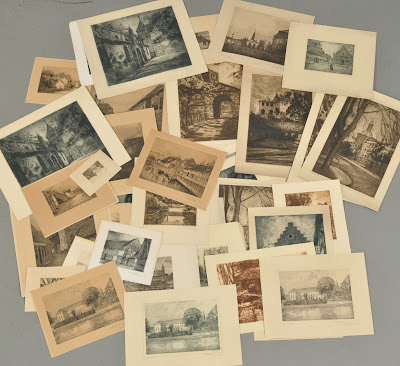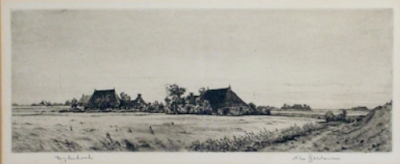Emile Gustaf Westman
(1894-1934)
Swedish printmaker
Stumbling over this Scandinavian etching of a blossoming tree and a visiting bee set a string of pictures and memories in motion that tells the story in what wondrous way the brain, my brain, is sometimes functioning.
Because I'd never heard of this artist before I did my best to find out more about him but nothing much came up in the www. "Pupil of (Anders) Zorn" the etcher-painter, it said somewhere. But Emil Gustaf must have been locally known according to this big pile of prints I found offered in a Scandinavian auction site although he seems now largely forgotten. Many of the prints showing Malmö buildings and sites I discovered.
Only once his name popped up: in the entry to his son's biography: Gunnar Millet Westman (1915-1985) also an artist and remembered best for his sculptural work. And finding a picture of this granit statue called "Bro Bro Brille" immediately rang a bell. I've walked passed it many many times the last 10 years working in Groningen in the University Medical Centre. It's a very intimate statue of a family and the children encircling the parents in a game. You won't ever forget it, stroking the cold but smooth granite, and with a smile on your face, walking past, either to work or homeward. And I must have seen it in childhood.
It is hewn from a huge used granite press and it was placed in 1958, bought and donated to the city of Groningen (Netherlands) after a Danish sculpture exhibition in 1955 in the Municipal Park, to celebrate the opening of the big V&D warehouse.
A decade after the destruction and rebuilding of what had been one of the best preserved and finest medieval market squares in Europe. 1955 was the year I (in my second year) returned with my parents from the tropics to the city of my forebears and living only a street length away to leave again a few years later the great and bustling and dynamic city of Groningen, capital of the North.
With Zorn and the foraging bee in my head the "connections" were made. Martin Erich Philipp: besides printmaking and painting and much like Zorn, was an etcher too. This sensitive "Rückenakt" (is it his wife Else Staps or a model standing at the window ?) imho his finest. It is probably far more affordable then a Zorn etching who I cannot help thinking, often has the air of a voyeur, camera in hand. Besides being a great painter and etcher of course. And now at the end of the stream it becomes obvious why the mind took such a detour after looking at a bee and blossoming tree. I don't know when Westman etched his but MEPH created his woodblock print in 1933. Both are lovely.
All pictures in this posting are borrowed freely from the Internet for friendly, educational and non commercial use only.




















+Portrait+of+Whistler.jpg)





























